| For the purpose of identification of the fossil Mako sharks, the teeth of recent mako sharks are examined accurately. According to the results, in this page , characteristics of recent mako shark teeth and those of fossil mako shark teeth from mainly Japan are shown. |
(1) Recent mako sharks
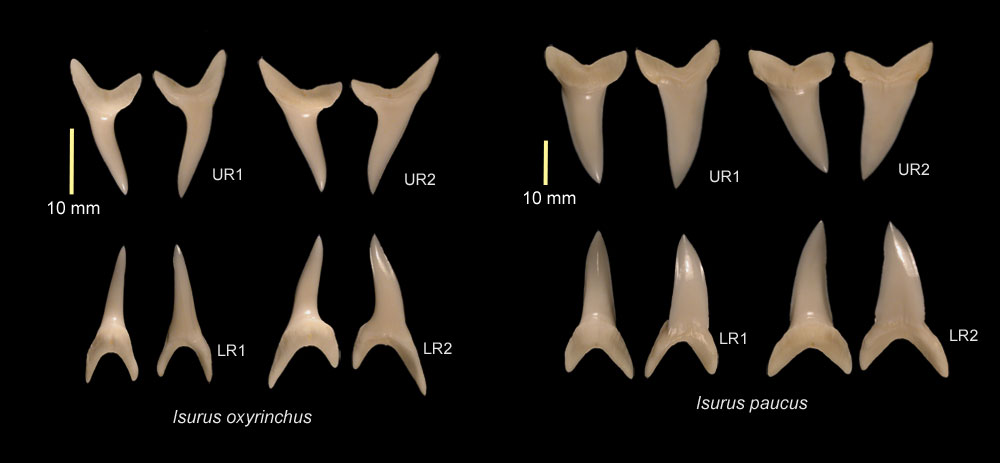
| Fig.1-1. Anterior teeth of recent Mako sharks. |
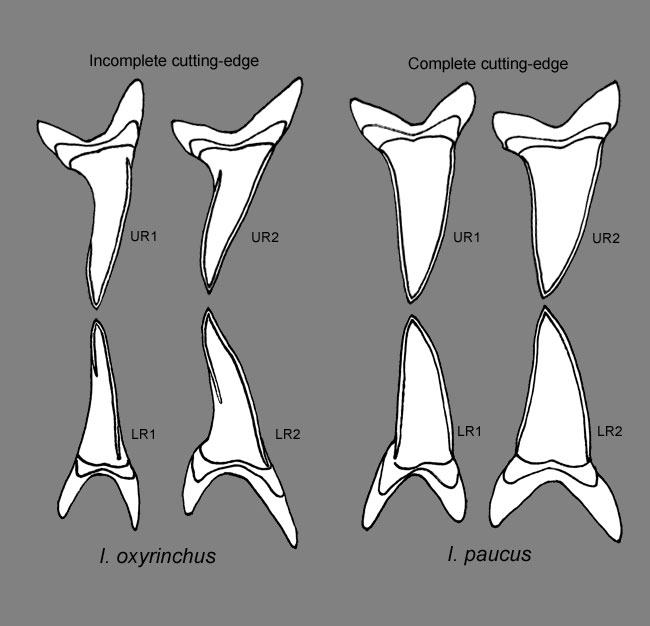
| Fig. 1-2. Cutting -edges of recent mako sharks |
| Each anterior tooth of Isurus oxyrinchus (shortfin mako shark) is different from one another in its contour and cutting-edge. The cuttting-edges are incomplete and the parts lacking in them are rounded. In Isurus paucus (longfin mako shark), the cusp is wider and thinner than I. oxyrinchus and the cutting-edge is complete. The cusp of Isurus bent strongly toward the rear on the lower tooth, while on the upper tooth it is almost straight. Most of the recent lamnids and odontaspids show almost the same characteristics on this point. |
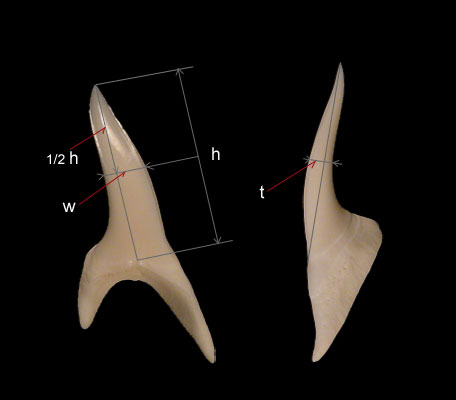 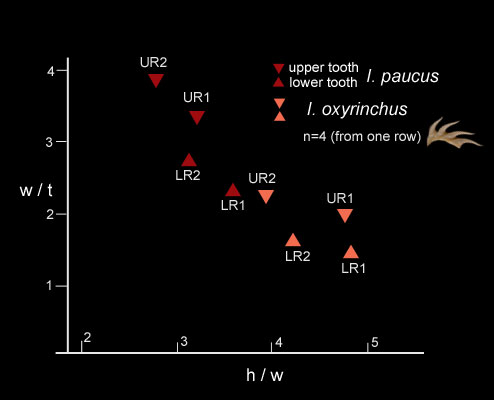 |
| Fig. 1-3. Measurement of the tooth crown and distribution pattern of the tooth proportion. |
| For specifyng the tooth characteristics, height(h), width(w) and thickness(t) of the selachian's cusp are measured as shown in the left side. Values, h/w and w/t are calculated as tooth proportions and then plotted as a point of each tooth in the graph as shown in the right side. |
(2) Middle Pleistocene
Ichijyuku Formation
| There are several active sand quarries around Ichijyku, Chiba prefecture, Japan . Those sites produce many kinds of fossils including especially whole whale bones. Shark teeth from the sites are originally very big and beatiful but unfotunately, we are able to collect them from the residues only after the fossil producing sediments were washed vigorously in water and take the sand out by sand-miners. (see Ichijyuku Formation) |
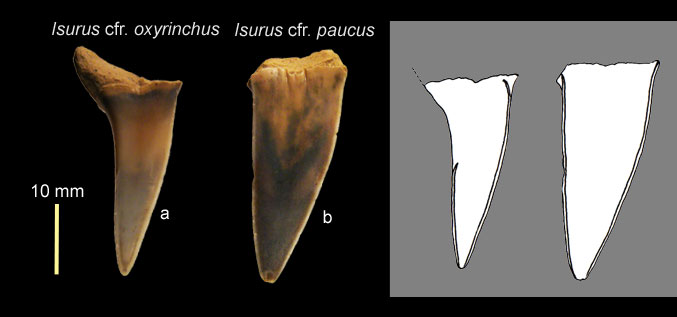
| Fig. 2-1. Two upper teeth from the Pleistocene of the Ichijyuku Formation, Chiba prefecture, Japan and their cutting edges |
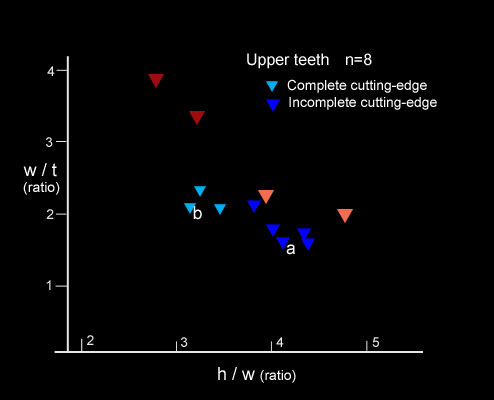 |
| Fig. 2-2. Ditribution pattern of the upper teeth from the Pleistocene of Ichijyuku |
| The teeth of Isurus obtained from Ichijyku, Chiba prefecture show two types of contours, I. cfr. oxirinchus and I. cfr. paucus as shown in Fig. 2-1. However, I. cfr oxirinchus from the sites has longer cutting-edge and thicker tooth than those of recent I. oxirinchus, and the tooth of I. cfr. paucus is also thichker than recent I. paucus. The distributin pattern of the upper teeth also indicate the facts (Fig. 2-2). |
(3) Early Pliocene
Lee Creek Mine, Yorktown Formation

| Fig. 3-1. Two specimens aka Isurus desori from the Early Pleistocene of the Lee Creek Mine |
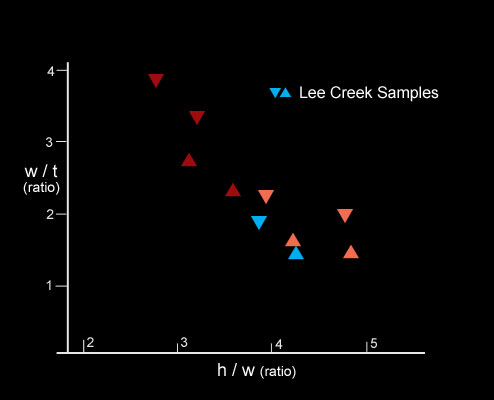
| Fig. 3-2. Distribution pattern of the samples from the Early Pliocene of the Lee Creek Mine |
| Teeth of Isurus from the Early Pliocene of the Lee creek Mine are known as I. desori. The teeth from this site are usually large in size and bear the nearly complete cutting-ede on both upper and lower cusps (Fig. 3-1.). Now there's a thought, that these teeth are referable to I. oxyrinchus . The contours and proportion pattern of the teeth (Fig. 3-1,3-2.) also suggest that these teeth are probably referable to I. oxirinchus with nearly complete cutteing-edge. |
(4) Late Miocene
Kyonan, Senhata Formation
| Kyonan, Chiba prefecture is one of the most famous locality in Japan. The horizon of the site is situated in the east-west direction, more than 2 Km in length, 1to 2 m in width and probably more than 10 m in depth, and occures vertically. Most of the fossil producing site occures in a low range of wooded hills. Near from this site, we can see a beautiful sea in the east direction. The site yields a variety of shark teeth and other remains such as elephant fish, whales, shells and sea urchins. (see Senhata Formation) |
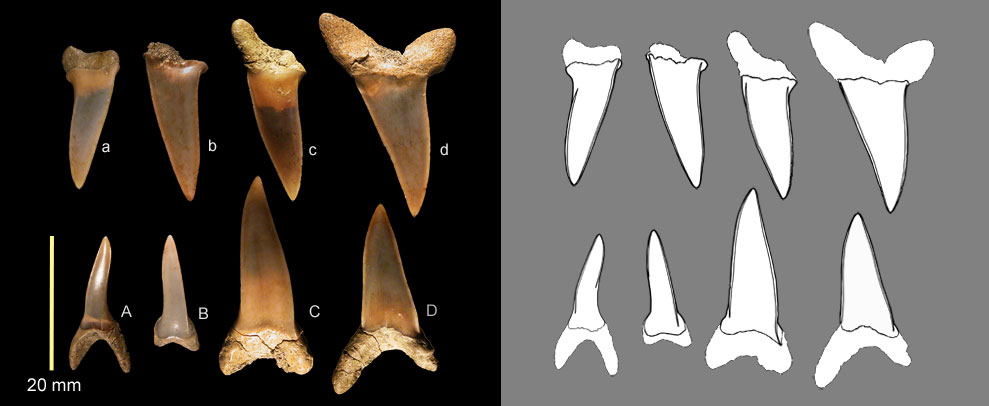
| Fig. 4-1. Specimens from the Late Miocene of Senhata, Chiba prefecture, Japan and their cutting edges |
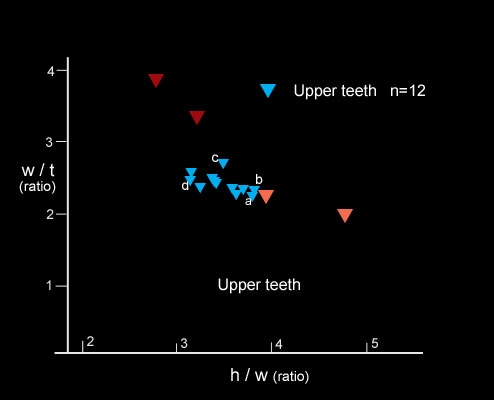
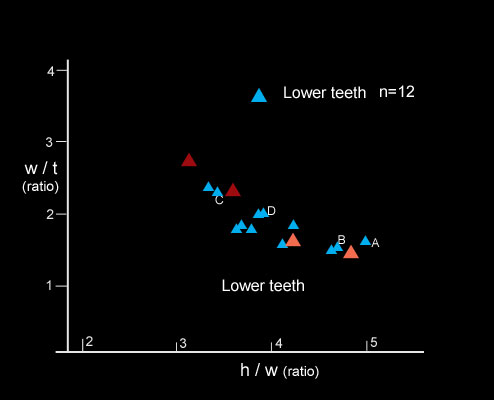
| Fig. 4-2. Distribution patterns of Specimens of Senhata. left, upper teeth; right, lower teeth. The upper shark teeth from the Senhata Formation show the intermediate cusp proportionths between I. oxirinchus and I. paucus (left), while the lower teeth show the wide vareity of cusp propotions which vary from those of I. oxirinchus to I. paucus (right). It seemes to me that the Isurus from the late Miocene of Senhata had just begun to diverge to two species, I. oxirinchus and I. paucus. In this period, however, the upper cusp of the species is thicker than that of recent I. paucus and thinner when compared to recent I. oxirinchus. |
(5) Early Miocene
Ichisi Group
| Ichishi group distributes widly from Aki county to Matsuzaka city in Mie prefectue. The horizons are 25 Km from south to north in length and 15 km from east to west in width. One of the famous fossil producing site among the group locates along the Nagano River nearby the Kaisekiyama with the meaning of shell-stones mountain in japanese. The place yields a lot of fossils such as shells, whale bones and shark teeth .. (see Ichisi Group) |

| Fig. 5-1. Three specimens from the Early Miocene of Ichisi Group. |
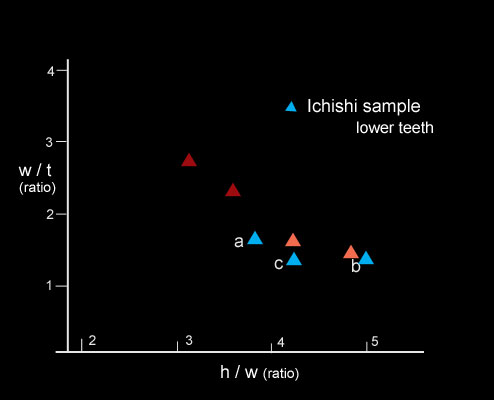
| Fig. 5-2. Distribution pattern of Ichisi samples. |
| The lower teeth from the Early Miocene of the Ichisi Formation are large in size and almost symmetrical. They have the shorter cutting-edge than that of recent I. oxyrinchus and show rounded cusp . The proportion pattern of the teeth (Fig. 5-2) shows that these teeth are probably referable to I. oxirinchus with short cutting-edge. |
(6) Eocene

| Fig. 6. Specimens from the Eocene of Kert, N. Mangyshlak Peninsula, Vogan, Togo and the Santee Limestone, U.S.A. |
| I. praecursor (Leriche, 1905,1906) and I. americanus are known well as Isurus/Cosmopolitadus from the Eocene. Both species are shown in Fig. 6. for help us in understanding Isurus/Cosmopolitadus. |